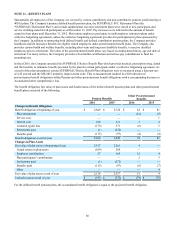Albertsons 2016 Annual Report Download - page 94
Download and view the complete annual report
Please find page 94 of the 2016 Albertsons annual report below. You can navigate through the pages in the report by either clicking on the pages listed below, or by using the keyword search tool below to find specific information within the annual report.
92
Estimated Future Benefit Payments
The estimated future benefit payments to be made from the Company’s defined benefit pension and other postretirement benefit
plans, which reflect expected future service, are as follows:
Fiscal Year Pension Benefits Other Postretirement
Benefits
2017 $ 154 $ 4
2018 135 4
2019 140 4
2020 148 4
2021 158 4
Years 2022-2026 843 20
Defined Contribution Plans
The Company sponsors defined contribution and profit sharing plans pursuant to Section 401(k) of the Internal Revenue Code.
Employees may contribute a portion of their eligible compensation to the plans on a pre-tax basis. The Company matches a
portion of employee contributions by contributing cash into the investment options selected by the employees. The total amount
contributed by the Company to the plans is determined by plan provisions or at the discretion of the Company. Total employer
contribution expenses for these plans were $8, $16 and $11 for fiscal 2016, 2015 and 2014, respectively. Matching
contributions were reduced or eliminated in January 2013 for most employees. The Company adopted and made a discretionary
match for fiscal 2015 for employees who had their matching contributions eliminated. There were no discretionary matches
made in fiscal 2016. Since June 2014, plan investment options do not include shares of the Company's common stock.
Post-Employment Benefits
The Company recognizes an obligation for benefits provided to former or inactive employees. The Company is self-insured for
certain disability plan programs, which comprise the primary benefits paid to inactive employees prior to retirement.
Amounts recognized in the Consolidated Balance Sheets consisted of the following:
Post-Employment Benefits
2016 2015
Accrued vacation, compensation and benefits $ 5 $ 8
Other long-term liabilities 8 10
Total $ 13 $ 18
Multiemployer Plans
The Company contributes to various multiemployer pension plans under collective bargaining agreements, primarily defined
benefit pension plans. These multiemployer plans generally provide retirement benefits to participants based on their service to
contributing employers. The benefits are paid from assets held in trust for that purpose. Plan trustees typically are responsible
for determining the level of benefits to be provided to participants as well as the investment of the assets and plan
administration. Trustees are appointed in equal number by employers and the unions that are parties to the collective bargaining
agreement.
Expense is recognized in connection with these plans as contributions are funded, in accordance with U.S. generally accepted
accounting standards. The Company contributed $43, $39 and $39 to these plans for fiscal years 2016, 2015 and 2014,
respectively. The risks of participating in these multiemployer plans are different from the risks associated with single-employer
plans in the following respects:
a. Assets contributed to the multiemployer plan by one employer are held in trust and may be used to provide benefits to
employees of other participating employers.
b. If a participating employer stops contributing to the plan, the unfunded obligations of the plan may be borne by the
remaining participating employers.
c. If the Company chooses to stop participating in some multiemployer plans, or makes market exits or store closures or
otherwise has participation in the plan drop below certain levels, the Company may be required to pay those plans an
amount based on the underfunded status of the plan, referred to as a withdrawal liability.
























